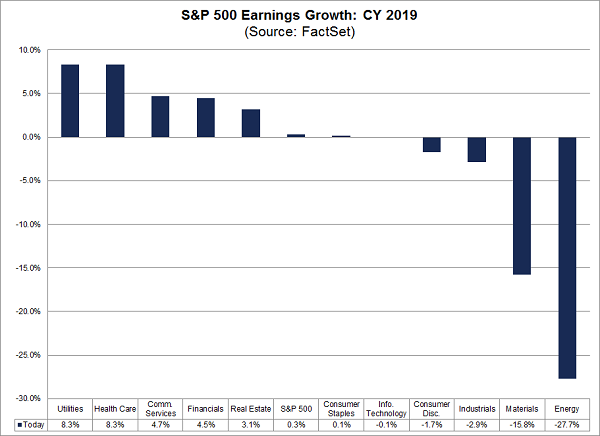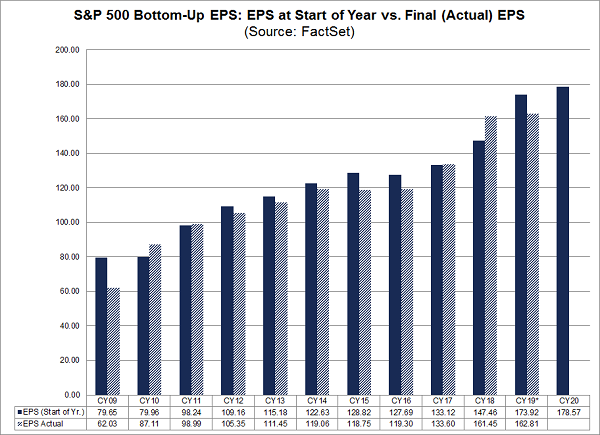Today we’re going to look ahead to 2020—and specific sectors to target for rising profits (and dividends!) in both stocks and 7%+ yielding closed-end funds (CEFs).
We’re also going to look inside a worrisome piece of news you might have heard about 2019—that analysts expect corporate profits to rise a meager 0.3% when they close the books on this year—and uncover why this is not a scary omen for the future.
Because when we hear numbers like that, we need to look further and see where they’re coming from. In this case, there’s a very simple reason no one is talking about.
2017, 2018 Set a High Bar
In 2017, corporate earnings soared 11.3%—high enough on its own. But S&P 500 companies followed that up with amazing 20.2% profit growth in 2018.
So why the dropoff this year?
First, 2017’s big jump was due in no small part to surging revenue (up a solid 6.5%). In 2018, sales jumped a massive 8.8%, again boosting profits. That brings us to 2019, which was unlikely to deliver big profit growth from the get-go, due to the big jumps in 2017 and 2018. Because, of course, growth like that can’t go on forever.
Here’s proof positive that this was the case: sales grew a still-solid 3.8% this year, a powerful signal that the profit slowdown isn’t because companies were finding it tough to sell their wares.
However, this does mean we need to be selective about the stocks and 7%+ yielding CEFs we buy. So let’s see where the strongest ones are lurking now.
Utility, Healthcare Stocks Are on a Roll

In 2019, we saw a trend that should surprise no one: a 27.7% decline in energy earnings as oil becomes less profitable. That has boosted utilities, which use resources to generate power, while rising demand for healthcare helped that sector, as well. Similarly, the big decline in materials earnings and the smaller loss for industrials are good news for other industries, like communication services, consumer staples and information technology, which rely on materials and industrials to make their products.
Look at it this way: 2019’s earnings slowdown was driven by lower margins for companies that make stuff for other companies, while companies that make stuff for consumers did well. And I expect these trends to continue in the months ahead.
You can see this in action with the Consumer Discretionary Select Sector SPDR (XLY), in blue below, and Technology Select Sector SPDR (XLK), in orange, compared to the Materials Select Sector SPDR ETF (XLB), in red, and Energy Select Sector SPDR ETF (XLE), in green.
Stocks Go Where the Profits Are

The sectors with faster profit growth delivered average returns of 35.7%, versus 14.7% returns for the companies with rapidly falling profits—the latter of which arguably should not have seen any positive return at all (but that’s fodder for another column!).
What to Expect in 2020
Another indication that sluggish 2019 profit growth is an aberration is analysts’ forecast for 2020: they’re calling for a return to the good old days, with profits jumping 9.6% from this year.
Analysts Aim High (Again)

There’s just one problem: can we trust the analysts?
Here’s a funny thing about Wall Street prognosticators: while they take heat for being wrong a lot, that’s not always true. Sure, when it comes to estimating quarterly earnings for a single company, they’re rarely close to being right. But with the bigger picture, they tend to be much closer to the target.
A glance at the chart above shows that when it comes to overall corporate profits, analysts aren’t far off. And if we go back the last two decades, we find that start-of-year estimates tend to overestimate actual profits by 6.9%. That’s a small margin, and it also includes three years of tremendous inaccuracies, including 2001, 2008 and 2009, when unexpected crises hit. Without those three years, start-of-year estimates are actually off by just 1.8%.
In short, if there are no unpredictable shocks in 2020, it’s shaping up to be a very good year for earnings, stocks—and CEFs.
Yours in 2020: 8.4% Dividends, 20% Upside: See How Here
With the market ticking higher every day and some loser sectors (I’m looking at you, materials and energy) undeserving of any gains at all, it’s tougher than ever to find bargains.
That’s why closed-end funds (CEFs) are your best bet at times like this. For one, there are bargains aplenty in the CEF space: of the roughly 500 CEFs out there, roughly 380 are trading at discounts to net asset value (NAV, or the value of their portfolios) right now.
Better still, these under-the-radar funds throw off huge cash dividends, with the average CEF yielding 7% as I write this.
And plenty yield even more, like the incredible 8.4% average yield paid by my 4 top CEFs for 2020 (and beyond). In other words, when you put your cash into these 4 funds, you’re essentially getting the historical return of US stocks in dividend cash alone, not to mention price gains.
And speaking of price gains, the discounts on these 4 funds are so big, I’m fully expecting their prices to jump 20% by this time next year—not including their huge cash payouts!
Full details are waiting for you now: simply click here and I’ll give you everything I have on these funds: names, tickers, best-buy prices, my complete take on each fund’s manager—the works!
